Tesco's Financial Health: A Detailed Ratio Analysis Report (2018-2020)
VerifiedAdded on 2023/06/18
|7
|1962
|347
Report
AI Summary
This report provides a financial analysis of Tesco plc over a three-year period, utilizing ratio analysis to assess the company's performance. It examines various profitability ratios such as return on shareholders' funds, return on capital employed, and profit margins, alongside operational ratios like net asset turnover and fixed asset turnover, and structure ratios including current and liquidity ratios. The analysis reveals trends in Tesco's financial health, highlighting areas of improvement and potential challenges. Additionally, the report discusses the limitations of ratio analysis, including its reliance on historical data, potential for misleading conclusions, and lack of standardized rules for interpretation. The conclusion emphasizes the need for Tesco to enhance its overall performance and acknowledges the insights gained from the ratio analysis, while also recognizing its inherent limitations. Desklib offers a platform to access this report and many other solved assignments.

Financial accounting
Paraphrase This Document
Need a fresh take? Get an instant paraphrase of this document with our AI Paraphraser
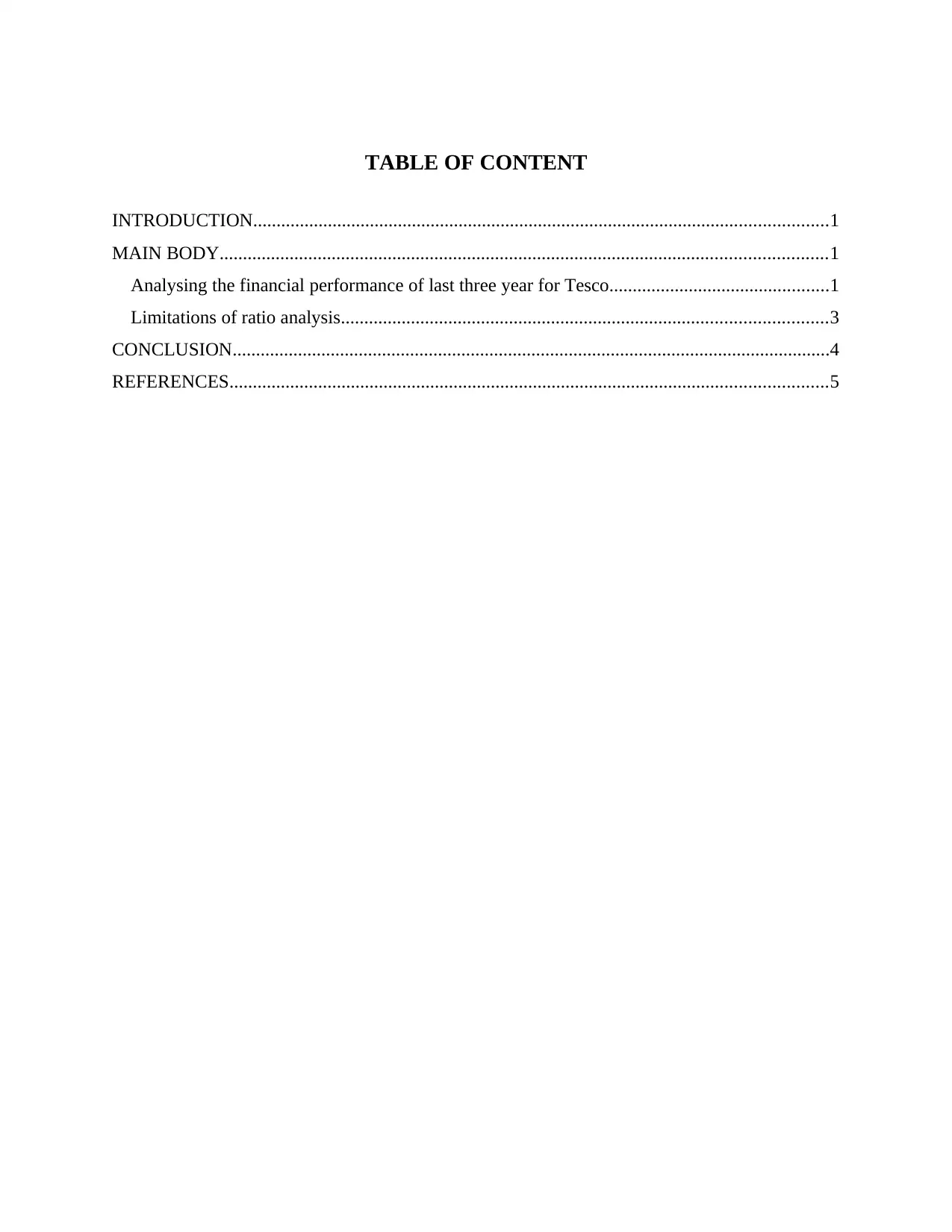
TABLE OF CONTENT
INTRODUCTION...........................................................................................................................1
MAIN BODY..................................................................................................................................1
Analysing the financial performance of last three year for Tesco...............................................1
Limitations of ratio analysis........................................................................................................3
CONCLUSION................................................................................................................................4
REFERENCES................................................................................................................................5
INTRODUCTION...........................................................................................................................1
MAIN BODY..................................................................................................................................1
Analysing the financial performance of last three year for Tesco...............................................1
Limitations of ratio analysis........................................................................................................3
CONCLUSION................................................................................................................................4
REFERENCES................................................................................................................................5
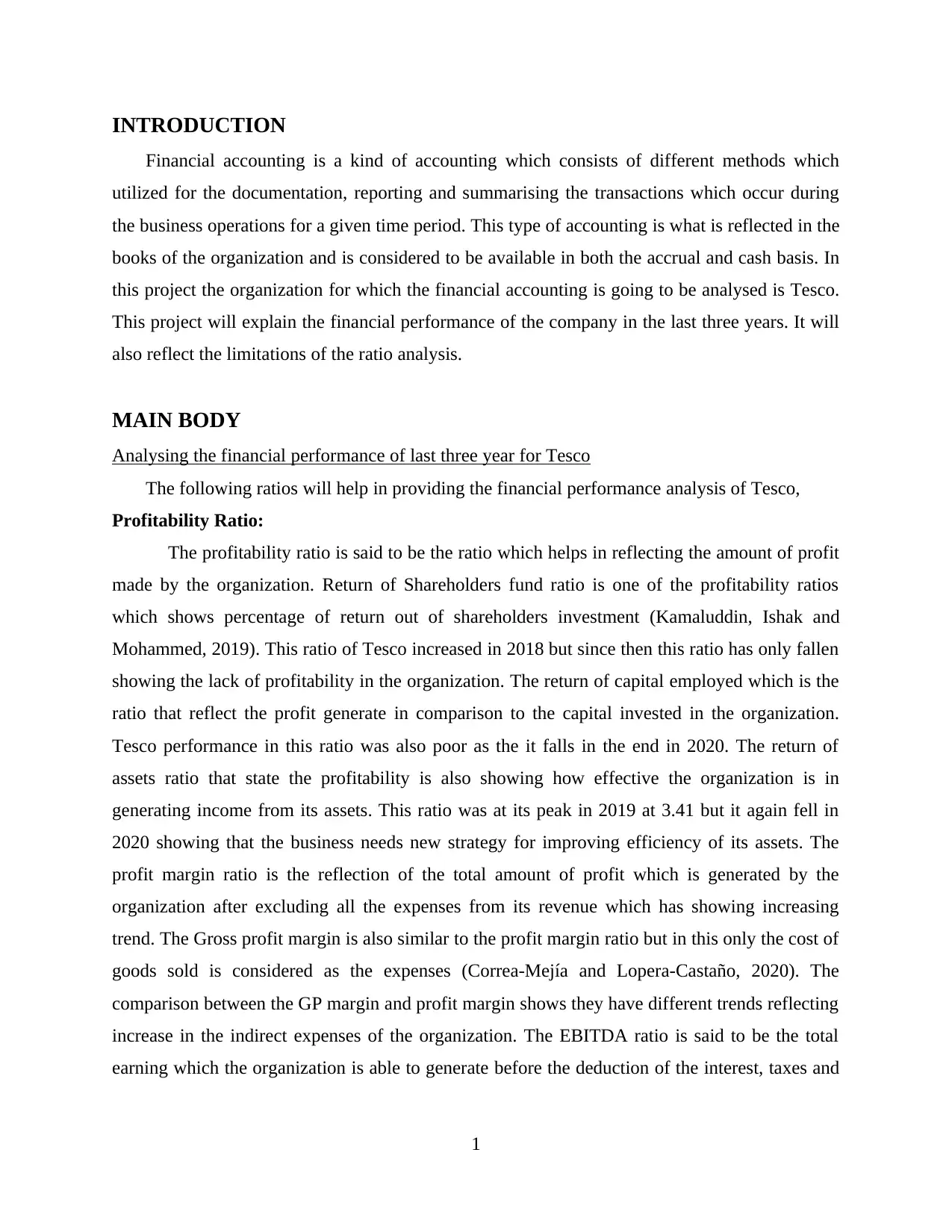
INTRODUCTION
Financial accounting is a kind of accounting which consists of different methods which
utilized for the documentation, reporting and summarising the transactions which occur during
the business operations for a given time period. This type of accounting is what is reflected in the
books of the organization and is considered to be available in both the accrual and cash basis. In
this project the organization for which the financial accounting is going to be analysed is Tesco.
This project will explain the financial performance of the company in the last three years. It will
also reflect the limitations of the ratio analysis.
MAIN BODY
Analysing the financial performance of last three year for Tesco
The following ratios will help in providing the financial performance analysis of Tesco,
Profitability Ratio:
The profitability ratio is said to be the ratio which helps in reflecting the amount of profit
made by the organization. Return of Shareholders fund ratio is one of the profitability ratios
which shows percentage of return out of shareholders investment (Kamaluddin, Ishak and
Mohammed, 2019). This ratio of Tesco increased in 2018 but since then this ratio has only fallen
showing the lack of profitability in the organization. The return of capital employed which is the
ratio that reflect the profit generate in comparison to the capital invested in the organization.
Tesco performance in this ratio was also poor as the it falls in the end in 2020. The return of
assets ratio that state the profitability is also showing how effective the organization is in
generating income from its assets. This ratio was at its peak in 2019 at 3.41 but it again fell in
2020 showing that the business needs new strategy for improving efficiency of its assets. The
profit margin ratio is the reflection of the total amount of profit which is generated by the
organization after excluding all the expenses from its revenue which has showing increasing
trend. The Gross profit margin is also similar to the profit margin ratio but in this only the cost of
goods sold is considered as the expenses (Correa-Mejía and Lopera-Castaño, 2020). The
comparison between the GP margin and profit margin shows they have different trends reflecting
increase in the indirect expenses of the organization. The EBITDA ratio is said to be the total
earning which the organization is able to generate before the deduction of the interest, taxes and
1
Financial accounting is a kind of accounting which consists of different methods which
utilized for the documentation, reporting and summarising the transactions which occur during
the business operations for a given time period. This type of accounting is what is reflected in the
books of the organization and is considered to be available in both the accrual and cash basis. In
this project the organization for which the financial accounting is going to be analysed is Tesco.
This project will explain the financial performance of the company in the last three years. It will
also reflect the limitations of the ratio analysis.
MAIN BODY
Analysing the financial performance of last three year for Tesco
The following ratios will help in providing the financial performance analysis of Tesco,
Profitability Ratio:
The profitability ratio is said to be the ratio which helps in reflecting the amount of profit
made by the organization. Return of Shareholders fund ratio is one of the profitability ratios
which shows percentage of return out of shareholders investment (Kamaluddin, Ishak and
Mohammed, 2019). This ratio of Tesco increased in 2018 but since then this ratio has only fallen
showing the lack of profitability in the organization. The return of capital employed which is the
ratio that reflect the profit generate in comparison to the capital invested in the organization.
Tesco performance in this ratio was also poor as the it falls in the end in 2020. The return of
assets ratio that state the profitability is also showing how effective the organization is in
generating income from its assets. This ratio was at its peak in 2019 at 3.41 but it again fell in
2020 showing that the business needs new strategy for improving efficiency of its assets. The
profit margin ratio is the reflection of the total amount of profit which is generated by the
organization after excluding all the expenses from its revenue which has showing increasing
trend. The Gross profit margin is also similar to the profit margin ratio but in this only the cost of
goods sold is considered as the expenses (Correa-Mejía and Lopera-Castaño, 2020). The
comparison between the GP margin and profit margin shows they have different trends reflecting
increase in the indirect expenses of the organization. The EBITDA ratio is said to be the total
earning which the organization is able to generate before the deduction of the interest, taxes and
1
⊘ This is a preview!⊘
Do you want full access?
Subscribe today to unlock all pages.

Trusted by 1+ million students worldwide
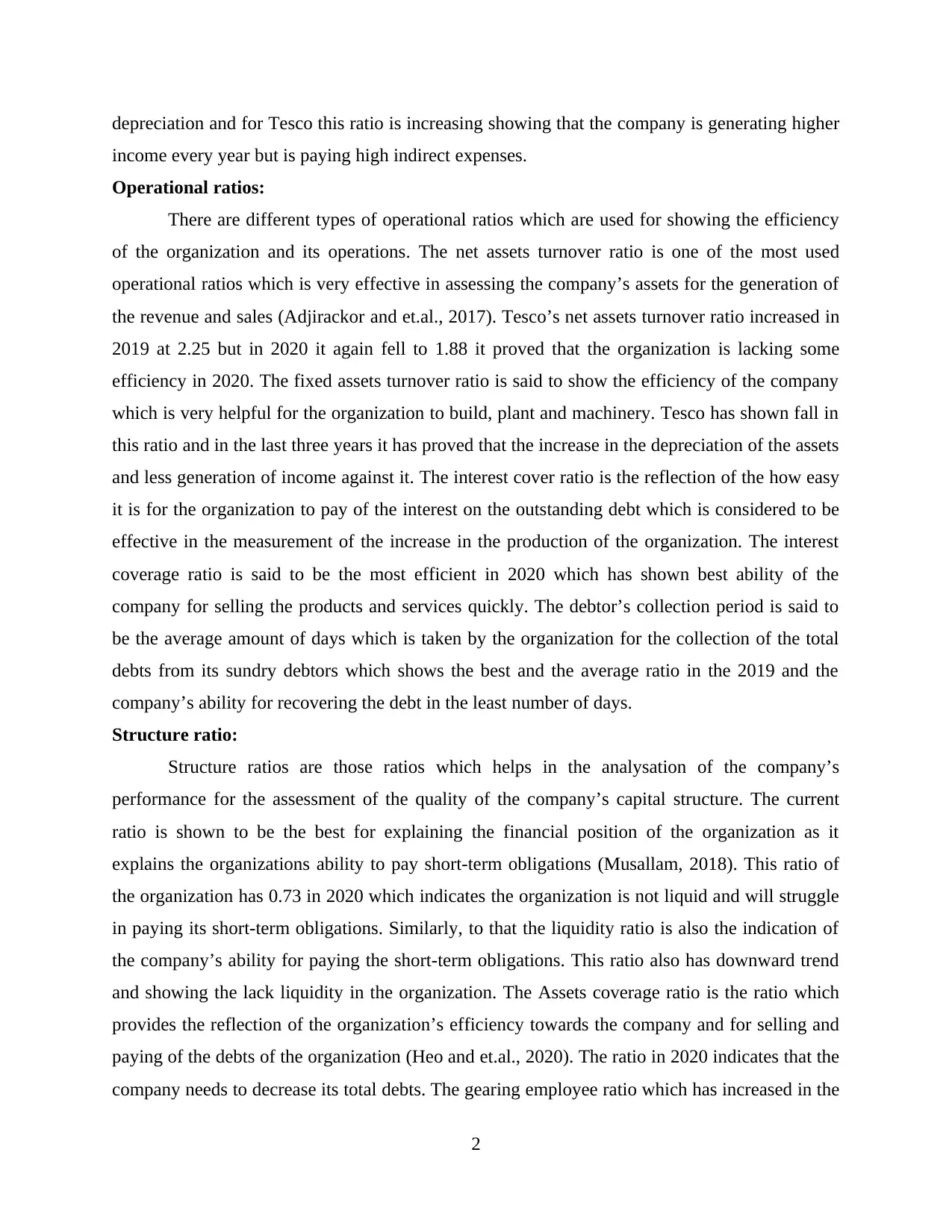
depreciation and for Tesco this ratio is increasing showing that the company is generating higher
income every year but is paying high indirect expenses.
Operational ratios:
There are different types of operational ratios which are used for showing the efficiency
of the organization and its operations. The net assets turnover ratio is one of the most used
operational ratios which is very effective in assessing the company’s assets for the generation of
the revenue and sales (Adjirackor and et.al., 2017). Tesco’s net assets turnover ratio increased in
2019 at 2.25 but in 2020 it again fell to 1.88 it proved that the organization is lacking some
efficiency in 2020. The fixed assets turnover ratio is said to show the efficiency of the company
which is very helpful for the organization to build, plant and machinery. Tesco has shown fall in
this ratio and in the last three years it has proved that the increase in the depreciation of the assets
and less generation of income against it. The interest cover ratio is the reflection of the how easy
it is for the organization to pay of the interest on the outstanding debt which is considered to be
effective in the measurement of the increase in the production of the organization. The interest
coverage ratio is said to be the most efficient in 2020 which has shown best ability of the
company for selling the products and services quickly. The debtor’s collection period is said to
be the average amount of days which is taken by the organization for the collection of the total
debts from its sundry debtors which shows the best and the average ratio in the 2019 and the
company’s ability for recovering the debt in the least number of days.
Structure ratio:
Structure ratios are those ratios which helps in the analysation of the company’s
performance for the assessment of the quality of the company’s capital structure. The current
ratio is shown to be the best for explaining the financial position of the organization as it
explains the organizations ability to pay short-term obligations (Musallam, 2018). This ratio of
the organization has 0.73 in 2020 which indicates the organization is not liquid and will struggle
in paying its short-term obligations. Similarly, to that the liquidity ratio is also the indication of
the company’s ability for paying the short-term obligations. This ratio also has downward trend
and showing the lack liquidity in the organization. The Assets coverage ratio is the ratio which
provides the reflection of the organization’s efficiency towards the company and for selling and
paying of the debts of the organization (Heo and et.al., 2020). The ratio in 2020 indicates that the
company needs to decrease its total debts. The gearing employee ratio which has increased in the
2
income every year but is paying high indirect expenses.
Operational ratios:
There are different types of operational ratios which are used for showing the efficiency
of the organization and its operations. The net assets turnover ratio is one of the most used
operational ratios which is very effective in assessing the company’s assets for the generation of
the revenue and sales (Adjirackor and et.al., 2017). Tesco’s net assets turnover ratio increased in
2019 at 2.25 but in 2020 it again fell to 1.88 it proved that the organization is lacking some
efficiency in 2020. The fixed assets turnover ratio is said to show the efficiency of the company
which is very helpful for the organization to build, plant and machinery. Tesco has shown fall in
this ratio and in the last three years it has proved that the increase in the depreciation of the assets
and less generation of income against it. The interest cover ratio is the reflection of the how easy
it is for the organization to pay of the interest on the outstanding debt which is considered to be
effective in the measurement of the increase in the production of the organization. The interest
coverage ratio is said to be the most efficient in 2020 which has shown best ability of the
company for selling the products and services quickly. The debtor’s collection period is said to
be the average amount of days which is taken by the organization for the collection of the total
debts from its sundry debtors which shows the best and the average ratio in the 2019 and the
company’s ability for recovering the debt in the least number of days.
Structure ratio:
Structure ratios are those ratios which helps in the analysation of the company’s
performance for the assessment of the quality of the company’s capital structure. The current
ratio is shown to be the best for explaining the financial position of the organization as it
explains the organizations ability to pay short-term obligations (Musallam, 2018). This ratio of
the organization has 0.73 in 2020 which indicates the organization is not liquid and will struggle
in paying its short-term obligations. Similarly, to that the liquidity ratio is also the indication of
the company’s ability for paying the short-term obligations. This ratio also has downward trend
and showing the lack liquidity in the organization. The Assets coverage ratio is the ratio which
provides the reflection of the organization’s efficiency towards the company and for selling and
paying of the debts of the organization (Heo and et.al., 2020). The ratio in 2020 indicates that the
company needs to decrease its total debts. The gearing employee ratio which has increased in the
2
Paraphrase This Document
Need a fresh take? Get an instant paraphrase of this document with our AI Paraphraser

year 2020 to 222.5 that was quite lower in the previous years shows that the organization has
either decreased its employees or has been able to increase their productivity with the help of
training and development. Another ratio that is the turnover per employee ratio shows how
efficient an employee in its contribution towards completing a turnover. This has a increasing
trend thus, showing the employees have been providing he business with high standards of
productivity in the last few years.
Limitations of ratio analysis
The limitations to the ratio analysis for their use in the analysation of a company’s
performance are,
Limited single ratio information:
The ratio analysis has different ratios which explain their own facts and figures about an
organization. They are the best example for the reflection of the financial aspect of the
organization. Thus, it can be said that the with the help of a single ratio very fewer financial
ratios can be developed (Giannopoulos and Sigbjornsen, 2019). A single ratio has been seen to
be unable to cover any relative meaning to the financial analysation. The combination of two or
more ratio is much more accurate in reflecting the actual performance of the business. Thus, as a
tool the ratio analysis is ineffective in the use of a single ratio.
Interfirm comparison:
It is understandable that the two organizations are never the same no matter how similar
are their operations, product and resources. It can be said that the ratio analysis does not have the
tools of identifying those differences. Due to which the ratios are unable to calculate the actual
difference in the organizations. This is important as mostly the financial ratios are used for
comparing two or more organizations. Even though they provide a scale of competition but their
accuracy in never 100%.
No rules and standards:
The analysation of the financial ratios is considered to have no established rules or
standards which is used for their interpretations (Mubashir and Bin Tariq, 2017). The result of
which is that there are different opinions on the same ratios and its utilization towards the
business and its analysation for the development of the same standards which will help the
organization in the analysation of the ratios which is considered to be more systematic in and
3
either decreased its employees or has been able to increase their productivity with the help of
training and development. Another ratio that is the turnover per employee ratio shows how
efficient an employee in its contribution towards completing a turnover. This has a increasing
trend thus, showing the employees have been providing he business with high standards of
productivity in the last few years.
Limitations of ratio analysis
The limitations to the ratio analysis for their use in the analysation of a company’s
performance are,
Limited single ratio information:
The ratio analysis has different ratios which explain their own facts and figures about an
organization. They are the best example for the reflection of the financial aspect of the
organization. Thus, it can be said that the with the help of a single ratio very fewer financial
ratios can be developed (Giannopoulos and Sigbjornsen, 2019). A single ratio has been seen to
be unable to cover any relative meaning to the financial analysation. The combination of two or
more ratio is much more accurate in reflecting the actual performance of the business. Thus, as a
tool the ratio analysis is ineffective in the use of a single ratio.
Interfirm comparison:
It is understandable that the two organizations are never the same no matter how similar
are their operations, product and resources. It can be said that the ratio analysis does not have the
tools of identifying those differences. Due to which the ratios are unable to calculate the actual
difference in the organizations. This is important as mostly the financial ratios are used for
comparing two or more organizations. Even though they provide a scale of competition but their
accuracy in never 100%.
No rules and standards:
The analysation of the financial ratios is considered to have no established rules or
standards which is used for their interpretations (Mubashir and Bin Tariq, 2017). The result of
which is that there are different opinions on the same ratios and its utilization towards the
business and its analysation for the development of the same standards which will help the
organization in the analysation of the ratios which is considered to be more systematic in and
3
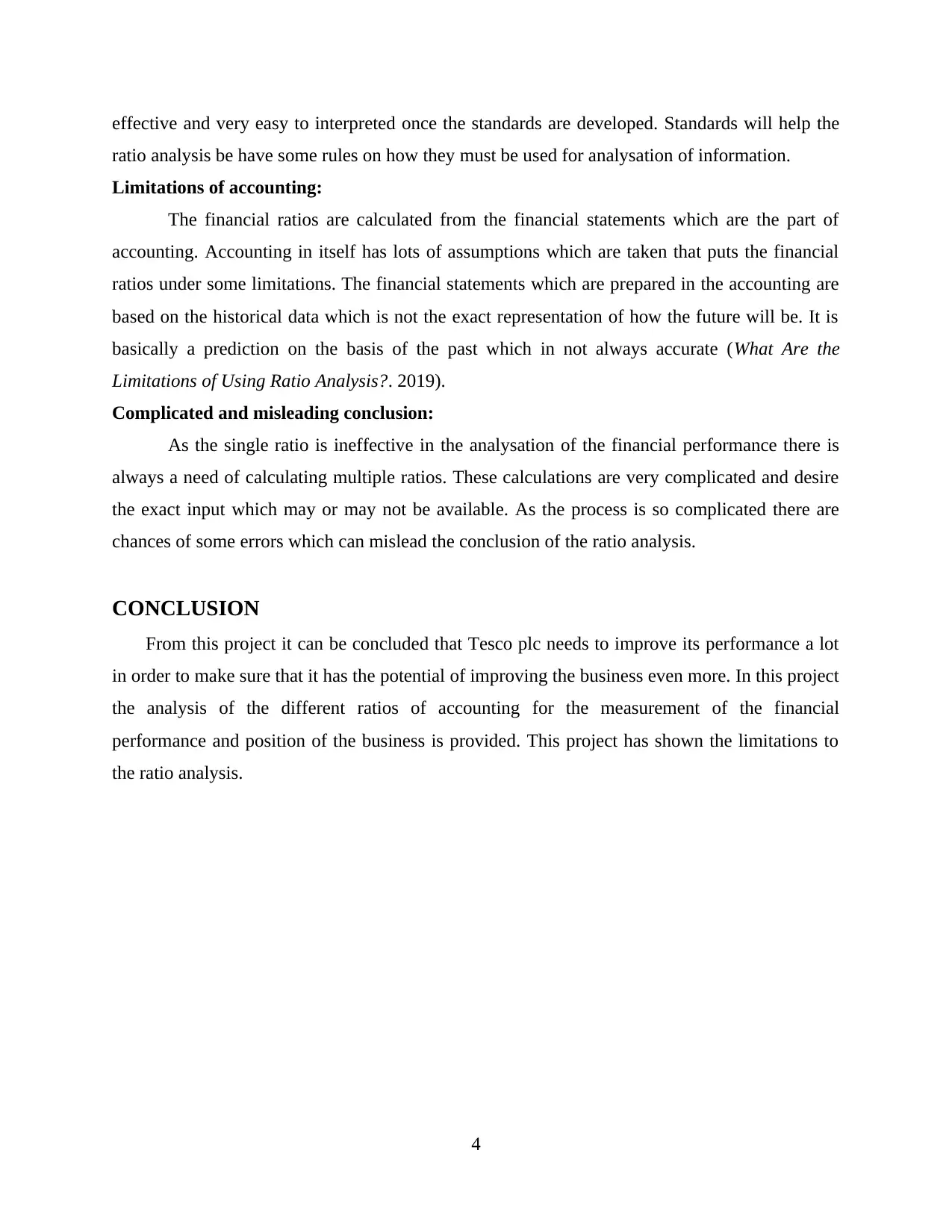
effective and very easy to interpreted once the standards are developed. Standards will help the
ratio analysis be have some rules on how they must be used for analysation of information.
Limitations of accounting:
The financial ratios are calculated from the financial statements which are the part of
accounting. Accounting in itself has lots of assumptions which are taken that puts the financial
ratios under some limitations. The financial statements which are prepared in the accounting are
based on the historical data which is not the exact representation of how the future will be. It is
basically a prediction on the basis of the past which in not always accurate (What Are the
Limitations of Using Ratio Analysis?. 2019).
Complicated and misleading conclusion:
As the single ratio is ineffective in the analysation of the financial performance there is
always a need of calculating multiple ratios. These calculations are very complicated and desire
the exact input which may or may not be available. As the process is so complicated there are
chances of some errors which can mislead the conclusion of the ratio analysis.
CONCLUSION
From this project it can be concluded that Tesco plc needs to improve its performance a lot
in order to make sure that it has the potential of improving the business even more. In this project
the analysis of the different ratios of accounting for the measurement of the financial
performance and position of the business is provided. This project has shown the limitations to
the ratio analysis.
4
ratio analysis be have some rules on how they must be used for analysation of information.
Limitations of accounting:
The financial ratios are calculated from the financial statements which are the part of
accounting. Accounting in itself has lots of assumptions which are taken that puts the financial
ratios under some limitations. The financial statements which are prepared in the accounting are
based on the historical data which is not the exact representation of how the future will be. It is
basically a prediction on the basis of the past which in not always accurate (What Are the
Limitations of Using Ratio Analysis?. 2019).
Complicated and misleading conclusion:
As the single ratio is ineffective in the analysation of the financial performance there is
always a need of calculating multiple ratios. These calculations are very complicated and desire
the exact input which may or may not be available. As the process is so complicated there are
chances of some errors which can mislead the conclusion of the ratio analysis.
CONCLUSION
From this project it can be concluded that Tesco plc needs to improve its performance a lot
in order to make sure that it has the potential of improving the business even more. In this project
the analysis of the different ratios of accounting for the measurement of the financial
performance and position of the business is provided. This project has shown the limitations to
the ratio analysis.
4
⊘ This is a preview!⊘
Do you want full access?
Subscribe today to unlock all pages.

Trusted by 1+ million students worldwide
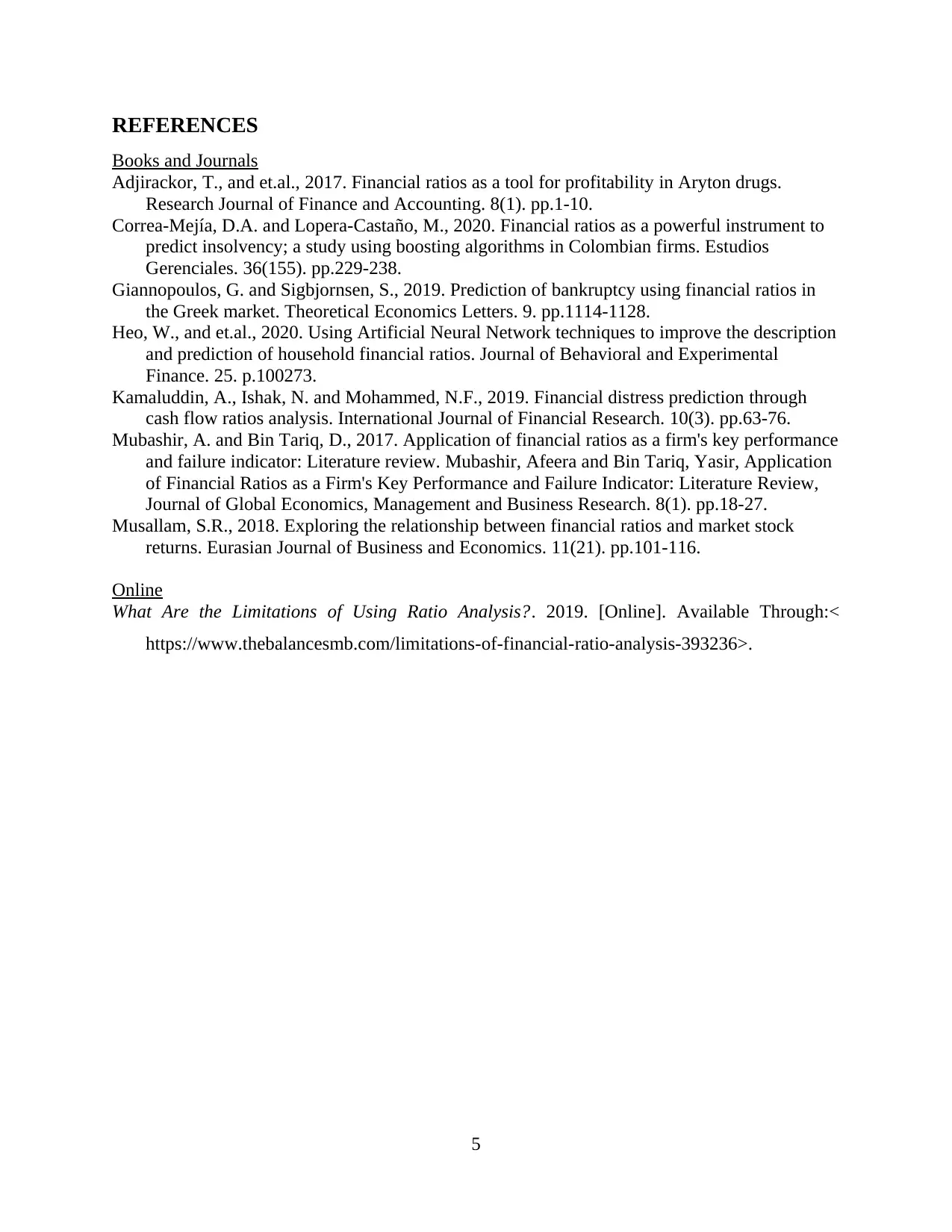
REFERENCES
Books and Journals
Adjirackor, T., and et.al., 2017. Financial ratios as a tool for profitability in Aryton drugs.
Research Journal of Finance and Accounting. 8(1). pp.1-10.
Correa-Mejía, D.A. and Lopera-Castaño, M., 2020. Financial ratios as a powerful instrument to
predict insolvency; a study using boosting algorithms in Colombian firms. Estudios
Gerenciales. 36(155). pp.229-238.
Giannopoulos, G. and Sigbjornsen, S., 2019. Prediction of bankruptcy using financial ratios in
the Greek market. Theoretical Economics Letters. 9. pp.1114-1128.
Heo, W., and et.al., 2020. Using Artificial Neural Network techniques to improve the description
and prediction of household financial ratios. Journal of Behavioral and Experimental
Finance. 25. p.100273.
Kamaluddin, A., Ishak, N. and Mohammed, N.F., 2019. Financial distress prediction through
cash flow ratios analysis. International Journal of Financial Research. 10(3). pp.63-76.
Mubashir, A. and Bin Tariq, D., 2017. Application of financial ratios as a firm's key performance
and failure indicator: Literature review. Mubashir, Afeera and Bin Tariq, Yasir, Application
of Financial Ratios as a Firm's Key Performance and Failure Indicator: Literature Review,
Journal of Global Economics, Management and Business Research. 8(1). pp.18-27.
Musallam, S.R., 2018. Exploring the relationship between financial ratios and market stock
returns. Eurasian Journal of Business and Economics. 11(21). pp.101-116.
Online
What Are the Limitations of Using Ratio Analysis?. 2019. [Online]. Available Through:<
https://www.thebalancesmb.com/limitations-of-financial-ratio-analysis-393236>.
5
Books and Journals
Adjirackor, T., and et.al., 2017. Financial ratios as a tool for profitability in Aryton drugs.
Research Journal of Finance and Accounting. 8(1). pp.1-10.
Correa-Mejía, D.A. and Lopera-Castaño, M., 2020. Financial ratios as a powerful instrument to
predict insolvency; a study using boosting algorithms in Colombian firms. Estudios
Gerenciales. 36(155). pp.229-238.
Giannopoulos, G. and Sigbjornsen, S., 2019. Prediction of bankruptcy using financial ratios in
the Greek market. Theoretical Economics Letters. 9. pp.1114-1128.
Heo, W., and et.al., 2020. Using Artificial Neural Network techniques to improve the description
and prediction of household financial ratios. Journal of Behavioral and Experimental
Finance. 25. p.100273.
Kamaluddin, A., Ishak, N. and Mohammed, N.F., 2019. Financial distress prediction through
cash flow ratios analysis. International Journal of Financial Research. 10(3). pp.63-76.
Mubashir, A. and Bin Tariq, D., 2017. Application of financial ratios as a firm's key performance
and failure indicator: Literature review. Mubashir, Afeera and Bin Tariq, Yasir, Application
of Financial Ratios as a Firm's Key Performance and Failure Indicator: Literature Review,
Journal of Global Economics, Management and Business Research. 8(1). pp.18-27.
Musallam, S.R., 2018. Exploring the relationship between financial ratios and market stock
returns. Eurasian Journal of Business and Economics. 11(21). pp.101-116.
Online
What Are the Limitations of Using Ratio Analysis?. 2019. [Online]. Available Through:<
https://www.thebalancesmb.com/limitations-of-financial-ratio-analysis-393236>.
5
1 out of 7